Dalai Lama and Lama Tsongkhapa: teachings on calm abiding meditation that go beyond “the breath” as the focus — targeting the main affliction
Buddha Weekly: Buddhist Practices, Mindfulness, Meditation. Copyright Buddha Weekly.
When we think of calm-abiding meditation, we might think of breath as the focal point of meditation. In-out. Follow the breath.
Breath, as a focal point, however, is just one of many targeted calm-abiding meditations. Breathing mindfulness is specifically recommended for people who are dominated by “conceptuality,” and who are unable to see beyond ordinary appearances.
Many types of calm-abiding focal points
Since modern people, especially Westerners, tend to be intellectual, analytical and “conceptual”, a meditation on the breath is the most frequently taught method. However, the focal point of any calm-abiding meditation, as taught by the Buddha, varies based on the discursive or afflictive emotion the student is “tackling” in their practice. The Dalai Lama writes: “Those dominated by conceptuality can observe the exhalation and inhalation of breath because by tying the mind to breath discursiveness diminishes.”
The Dalai Lama, in his teaching commentary on Lama Tsongkahapa’s The Great Exposition of Secret Mantra (Vol.3), provides significant guidance for students. In this feature, we’ll focus on the advice of Shakyamuni Buddha, His Holiness the Dalai Lama, and the great Lama Tsongkhapa on topics for calm abiding meditation that suit your obstructions.[1]
Choosing the “object”
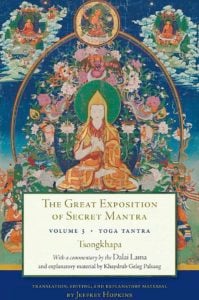
Teaching from the Dalai Lama quoted from the commentary to The Great Exposition of Secret Mantra, Volume 3.
Whether we choose to visualize a Buddha, focus on a mantra, or just on our breath, depends on the result we expect or hope for.
The Dalai Lama explains: “In order to set the mind steadily on an object of observation it is necessary initially to use an object of observation suited to counteracting your own predominant afflictive emotion since its force remains with your mind now and can easily interrupt any attempt to concentrate the mind.”
His Holiness then went on to describe the different afflictive emotions, and which contemplation works best — according to the teachings of Shakyamuni Buddha. The afflictive emotions include:
- conceptuality
- desire
- hate
- pride
- obscuration or dullness
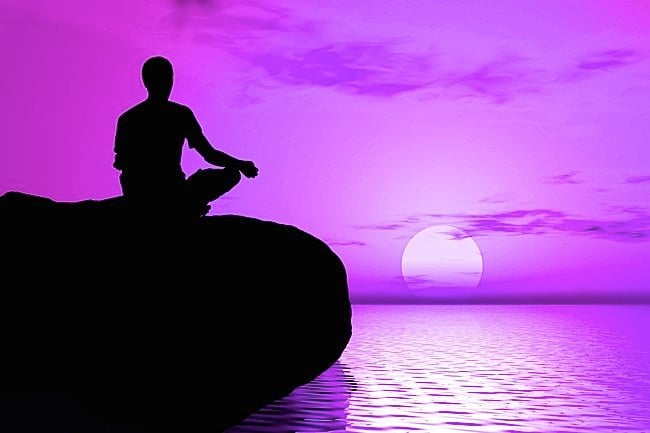
For calm-abiding meditation, the Dalai Lama and Lama Tsongkhapa teach that the object of meditation should be determined, in part, by the obstacle or troublesome stress in your life.
There are others, but these cover the primary afflictions. The Dalai Lama pointed out instructions for each:
- Conceptual — main focus: breath.
- Desire — main focus: meditate on “ugliness” such as the organs, faeces and blood of the body.
- Hatred — main focus: “Metta” and “love” meditation, Bodhichitta, loving kindness.
- Pride — main focus: a meditation on the divisions of the constituents (fire, water, earth, wind, space and consciousness: breaking them down to their respective constituents, such as, for earth: flesh, skin, bone.) By breaking down the constituents to it’s insignificant components you lose the inflated ego, and realize.
- Obscuration and dullness: meditate on the twelve links of dependent arising of cyclic existence because it sharpens thinking and intelligence.
Buddha body object

HH the Dalai Lama in front of a sacred thangka depicting Lama Tsongkhapa. Lama Tsongkhapa wrote The Great Exposition of Secret Mantra on which the Dalai Lama offers commentary.
His Holiness explains that all meditations can benefit from the “Buddha’s body” object of meditation:
“A particularly helpful object for all personality types is a Buddha body, since concentration on a Buddha’s body causes your mind to mix with virtuous qualities. No matter what the object is, this is not a case of meditating within, looking at an external object with your eyes, but of causing an image of it to appear to the mental consciousness.”
His Holiness then described how the process might work. “For instance, if you are to concentrate on Buddha body, first you need to come to know it well through hearing it described or through looking at a picture or statue, getting used to it, so that it can appear clearly in the mind. Then, imagine it about four feet in front of you at the height of your eyebrows, about two inches high. It should be meditated as being clear, with a nature of brilliant light; this helps to prevent the onset of laxity, a condition in which the mind’s mode of apprehension is too loose. Also, you can consider the imagined Buddha body to be heavy; this helps to prevent excitement, a condition in which the mind’s mode of apprehension is too light. Once the object originally has been determined, you may not change its nature or size; it must be fixed for the duration of generating calm abiding.”
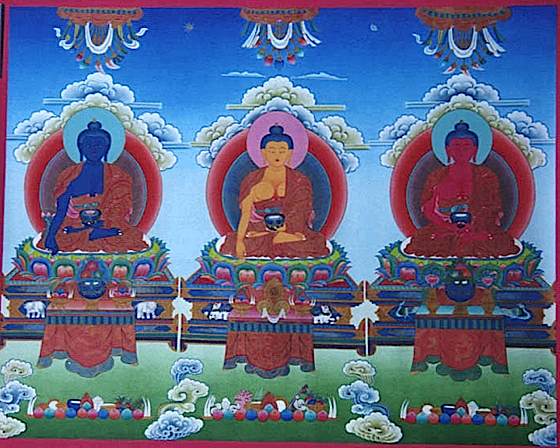
Medicine Buddha (left), Shakyamuni Buddha (centre) and Amitabha Buddha (right) are among the most popular Buddha Body visualizations.
The Buddha body specialists
Typically, a “Buddha body object” would be one’s own Yidam, although there are “specialist” emanations of Buddha bodies for most afflictions. For example, the five Buddha Families oppose or transform the same five major stresses. Although the attributions are slightly different between Buddhist schools, they are, generally:
- Conceptual: the stress of mental formations and concepts is opposed by the karma activities of Amoghasiddhi (Karma family)
- Desire: the stress of “desires” and clinging is opposed by the generosity of Ratnasambhava (Ratna family)
- Hatred: the stress of hatred is opposed by Amitabha (Lotus family), the compassion family
- Pride: the stress of pride is opposed or transformed by the humility of Akshobya (Vajra family)
- Obscuration or dullness: the stress of “Ignorance” is opposed or transformed the wisdom of Vairocana and his family
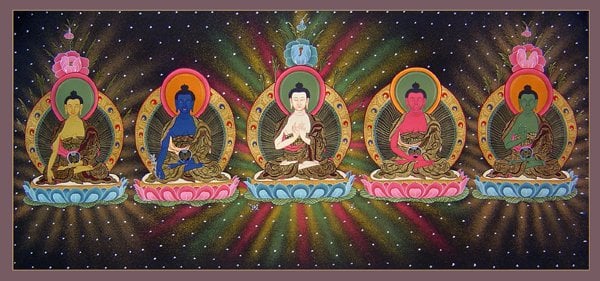
The Five Buddhas: from left to right Ratnasambhava (gold), Akshobya (blue), Vairochana (white), Amitabha (red), and Amoghisiddi (green).
These families and other meditation deities “oppose” the five stresses with their own special emphasis: Desire is opposed by generosity; hatred is opposed by love and Metta; Pride is overcome by humility; and so on. For more specific meditations, there are also many deity practices that focus on these “stresses”:
-

One of the beautiful thangkas that kept showing up on the author’s Facebook feed. This is the Green Tara final art that we see Jampay Dorje working on in the feature image.
Green Tara (member of Amoghasiddhi’s family) or Prajnaparamita for “conceptual” and also the Heart Sutra teachings. [For a feature on Green Tara see>>] [For a story on Prajnaparamita and Heart Sutra see>>]
- Jambhala practice is often recommended for “desire” (practicing generosity to overcome greed); also Kshitigarbha (Earth Store Bodhisattva) [For a story on Kshitigarbha see>>]; Vajrayogini is recommended for “sensual desire” [For a story on Vajrayogini, see>>]
- Avalokiteshvara (Chenrezig) for “hatred” [For a feature story on Chenrezig, see>>]
- Vajrasattva to help us overcome “pride” through confession of our downfalls [For a feature on Vajrasattva see>>]
- Manjushri (wisdom deity) for “obscuration and dullness”
If you’re really stuck, go wrathful
Only if you have appropriate initiation and full instruction from a teacher, if you are really stuck, you can also “up” the horse-power in your practice by meditating on the “wrathful” emanation of the same deity (assuming you have permission or empowerment). [For a feature story on wrathful deities, see>>]
For example:
- Wrathful Dakinis (Wisdom Dakinis) such as Ekajati, Vajra Varahi, even Palden Lhamo (who famously renounced conceptuality in her gruesome story) and is famous for driving off our inner demons and afflictions. [For a feature on Palden Lhamo, see>>]
- White Mahakala for general “desire”; Kurukulle, another wrathful emanation of Tara is also recommended for “desire”.
-
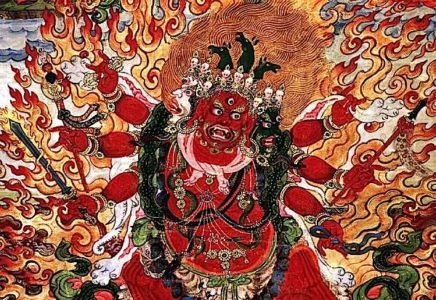
The terrifyingly beautiful visualization of the most “Powerful of Herukas” Hayagriva. This stunning image is from a Rubin Museum canvas dated between 1800 and 1899.
Hayagriva as the wrathful emanation of Chenrezig and Amitabha — again for hatred (Hayagriva is also good for many other obscurations). [For a feature story on Hayagriva, see>>]
- Vajrakilaya, a wrathful emanation of Vajrasattva (famously, the practice that most often involves wrathful Phurba.) [For a story on Phurba, see>>]
- Yamantaka as a wrathful emanation of Manjushri (the Buddha of Wisdom) — again for “dullness”
Excitement and laxity
Whatever the focus — breath, metta, or a deity — His Holiness advised us to develop:
- clarity of both object and consciousness itself
- staying one-pointedly on the object.
The two factors that prevent this are laxity and excitement. “Laxity prevents the development of clarity, and excitement prevents the stability with the object,” writes the Dalai Lama.
“That which interferes with the steadiness of the object of observation and causes it to fluctuate is excitement, which includes any scattering of the mind to an object other than the object of meditation. To stop that, withdraw your mind more strongly inside so the intensity of the mode of apprehension of the object begins to lower. If you need a further technique to withdraw the mind, it helps to leave the object of meditation temporarily and think about something that makes you more sober, such as the imminence of death…”

His Holiness speaking.
When speaking of laxity, His Holiness explains:
“It is not sufficient just to have stability; clarity is also needed. That which prevents clarity is laxity, which is a case of the mind’s becoming too relaxed, too loose, lacking intensity — the tautness of the mind having become weak, caused by over withdrawal inside.
Heaviness of mind and body can lead to becoming lax, which can lead to a type of lethargy in which, losing the object of observation, you have as if fallen into darkness; this can lead even to sleep.”
As a remedy for laxity, the Dalai Lama recommends: “When this begins to occur, it is necessary to raise, to heighten, this excessive declination of the mind by making it more taught, more tight. If you need a further technique to accomplish this, it helps to brighten the object of meditation, or if that does not work, to leave the object of meditation temporarily and think on something that makes you joyous, such as the wonderful opportunity that a human lifetime affords for spiritual practice…”
NOTES
[1] The Great Exposition of Secret Mantra (Vol.3), by Lama Tsongkhapa with commentary from H.H. Dalai Lama
- Series: Exposition of Secret Mantra (Book 3)
- Paperback: 240 pages
- Publisher: Snow Lion (May 2, 2017)
- Language: English
- ISBN-10: 1611803608
- ISBN-13: 978-1611803600
The post Dalai Lama and Lama Tsongkhapa: teachings on calm abiding meditation that go beyond “the breath” as the focus — targeting the main affliction appeared first on Buddha Weekly: Buddhist Practices, Mindfulness, Meditation.
from Buddha Weekly: Buddhist Practices, Mindfulness, Meditation https://ift.tt/2ShD1jD

Post a Comment